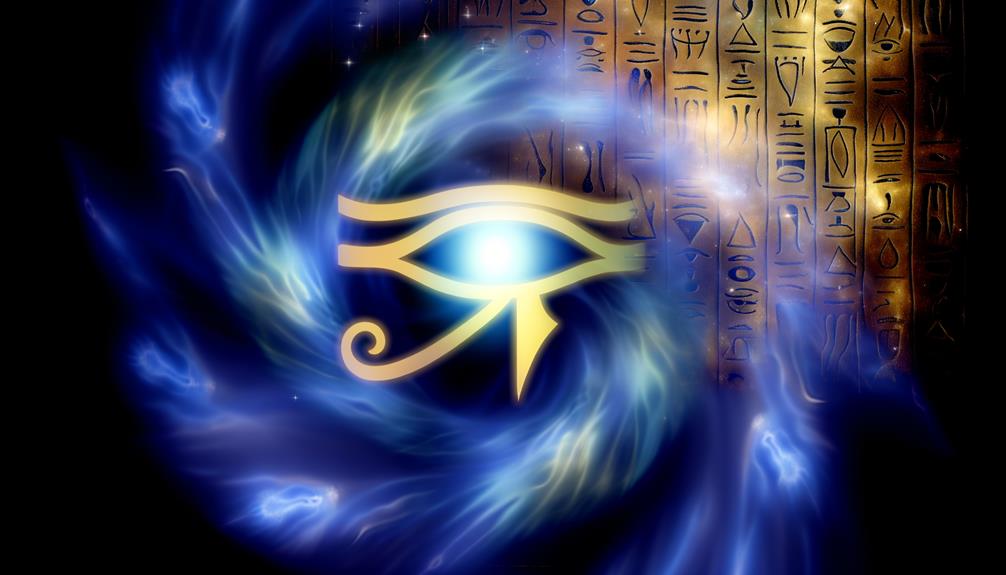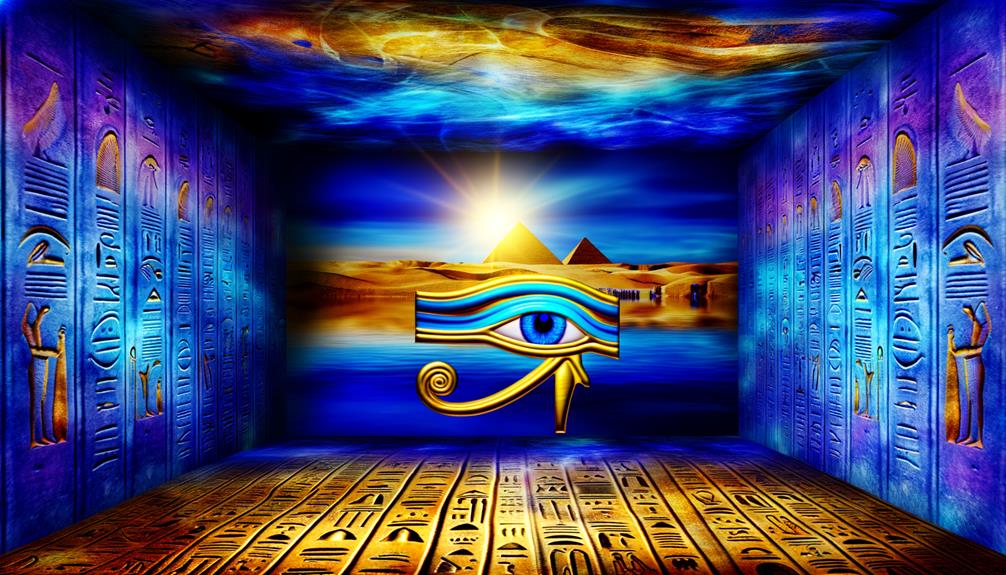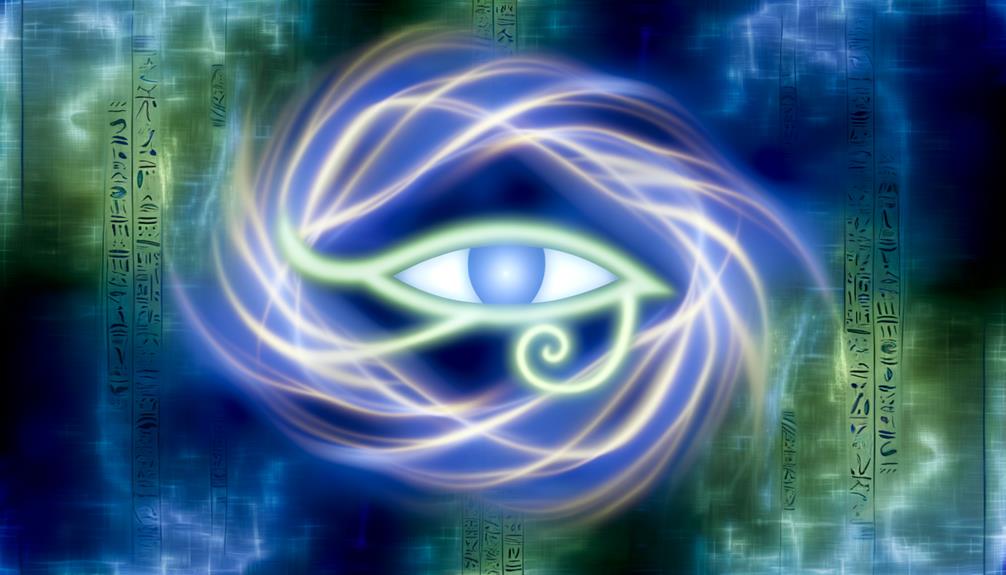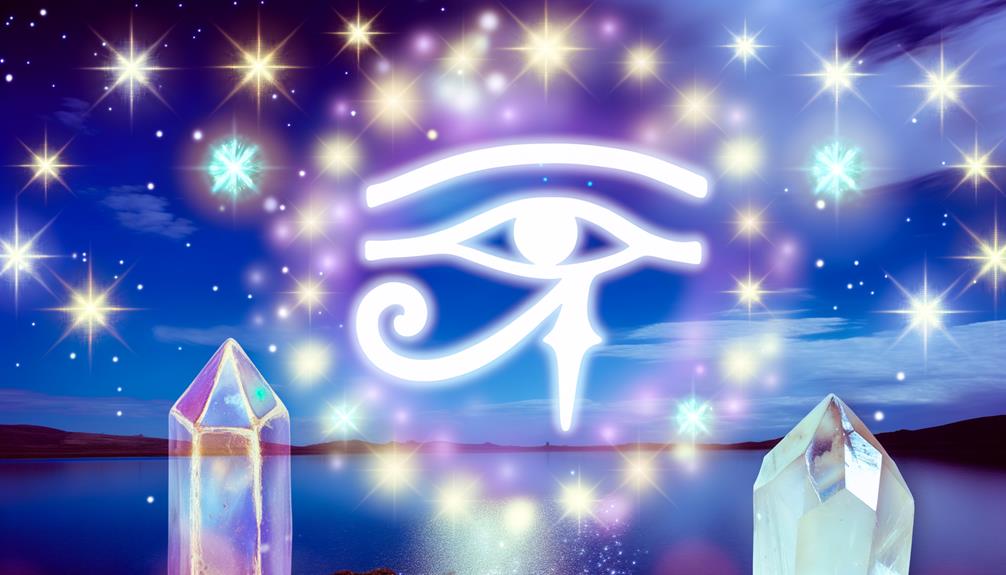Eye of Horus Meaning Spiritual: Divine Insight
The Eye of Horus, deeply embedded in ancient Egyptian mythology, signifies spiritual protection, healing, and enlightenment. Dating back to Horus’s battle with Set, this symbol, restored by Thoth, embodies the triumph of order over chaos.
It is often found on amulets and inscriptions, ensuring well-being and safeguarding against malevolent energies. Symbolically, it represents divine oversight, holistic health, and profound insight.
Revered in rituals and modern spiritual practices alike, it harmoniously connects the earthly with the divine. Understanding its rich historical and esoteric significance reveals a deeper connection to themes of recovery, empowerment, and divine communion.

Spiritual Meaning of the Eye of Horus: Protection, Healing, and Divine Insight
| Symbolic Aspect | Spiritual Interpretation |
|---|---|
| Protection | Shields against negative energy and spiritual harm |
| Healing | Represents restoration and health on all levels |
| Wisdom | Symbol of divine knowledge and spiritual insight |
| Intuition | Enhances awareness and connection to higher self |
| Balance and Harmony | Reflects unity of body, mind, and spirit |
Origins of the Eye of Horus

The Eye of Horus, an ancient Egyptian symbol imbued with profound cultural and spiritual significance, traces its origins to the mythological conflict between the gods Horus and Set.
This myth recounts the fierce battle where Horus, the falcon-headed deity symbolizing kingship and the sky, lost his left eye to Set, the god of chaos and disorder.
After the battle, the god Thoth, associated with wisdom and magic, restored Horus’s eye, henceforth known as the ‘Wadjet,’ or ‘Udjat.’
The restoration symbolized healing and protection, embedding the Eye of Horus deeply into Egyptian cultural consciousness.
Its depiction, often seen in amulets and inscriptions, served not only as a protective talisman but also as an emblem of divine order and restoration.
Symbolism and Meaning
The Eye of Horus, rooted in ancient Egyptian mythology, serves as a potent emblem of protection, royal power, and good health.
This symbol, intricately linked to the deity Horus, reflects profound cultural beliefs about the interplay of sight, perception, and cosmic order.
In contemporary spiritual practices, it continues to evoke meanings of healing, safeguarding, and holistic insight, bridging millennia of human interpretation and reverence.
Ancient Egyptian Significance
Among the myriad symbols of ancient Egyptian mythology, the Eye of Horus stands as a profound emblem of protection, royal power, and health. Rooted deeply in the story of Horus, the falcon-headed god, this symbol transcends mere imagery to convey complex spiritual significance.
- Protection: Believed to ward off evil and safeguard the wearer, it was often used in amulets.
- Royal Power: Representing divine kingship, it was integral to pharaonic regalia, symbolizing the ruler’s god-given authority.
- Health: Known as the ‘Wadjet Eye,’ it was associated with restoration and healing, linked to Horus’ mythical recovery of his eye.
Thus, the Eye of Horus encapsulates a multifaceted legacy, deeply interwoven with the spiritual and political fabric of ancient Egypt.
Modern Spiritual Interpretations
Drawing from its rich historical roots, the Eye of Horus today is revered in modern spiritual practices as a potent symbol of protection, insight, and connection to ancient wisdom.
Often depicted as a stylized human eye, this emblem is believed to ward off negative energies and offer a shield against harm. In contemporary spiritual circles, it is also interpreted as a beacon of inner vision, guiding individuals toward enlightenment and self-discovery.
The Eye of Horus embodies a synthesis of ancient Egyptian reverence for divine oversight and modern quests for personal empowerment.
Its recurring presence in amulets, jewelry, and art signifies a bridge between historical reverence and contemporary spiritual aspirations, reflecting an enduring legacy of profound symbolic resonance.
Healing and Protection

In the context of ancient Egyptian culture, the Eye of Horus, or ‘Wedjat,’ is imbued with profound symbolic healing properties, believed to restore health through its sacred geometry.
As a protective amulet, it was commonly worn or depicted in funerary art to safeguard individuals from malevolent forces.
Additionally, its integration into ritual practices underscores its significance, where it was utilized in ceremonies aimed at invoking divine intervention for physical and spiritual restoration.
Symbolic Healing Properties
The Eye of Horus, steeped in ancient Egyptian mythology, serves as a potent symbol of healing and protection, believed to harness divine power for restoring health and warding off malevolent forces. Its symbolic healing properties are derived from the myth of Horus’s eye being restored by Thoth, the god of wisdom. This myth underscores the Eye’s multifaceted significance:
- Physical Healing: The Eye represents the restoration of physical well-being, symbolizing recovery and strength.
- Spiritual Rejuvenation: It embodies the renewal of spiritual energy, aligning the soul with divine energies.
- Psychic Protection: The Eye acts as a shield against negative energies and psychic attacks, maintaining mental and emotional balance.
Thus, the Eye of Horus remains a timeless emblem of holistic health.
Protective Amulet Significance
Frequently revered in ancient Egyptian culture, the Eye of Horus amulet was meticulously crafted to serve as a powerful symbol of both healing and protection, embodying the divine intervention believed to safeguard its bearer from physical and spiritual harm.
This amulet, often fashioned from materials like gold, lapis lazuli, and carnelian, was imbued with potent symbolism. It represented the restored eye of the god Horus, signifying recovery and defense against malevolent forces. The Eye of Horus was not merely an ornament; it was an essential spiritual tool worn by individuals to invoke divine oversight.
| Element | Material Used | Symbolic Significance |
|---|---|---|
| Eye of Horus | Gold | Divine protection and healing |
| Craftsmanship | Lapis Lazuli | Spiritual insight and wisdom |
| Amulet Form | Carnelian | Importance and life force |
Ancient Ritual Practices
Amid the sacred rituals of ancient Egypt, the Eye of Horus played a pivotal role in ceremonies designed to invoke healing and divine protection. This symbol, deeply embedded within the spiritual fabric of the culture, was believed to harness cosmic energy and channel it towards restoring balance and safeguarding individuals.
The Eye of Horus was intricately involved in:
- Healing Rituals: Priests utilized the symbol in medicinal practices, believing it could cure ailments and restore physical health.
- Protective Spells: The Eye was inscribed on amulets, shields, and even tombs to ward off malevolent forces.
- Funerary Rites: It was used to guarantee safe passage to the afterlife, protecting the deceased from spiritual harm.
These practices underscore the Eye’s profound significance in maintaining both physical and metaphysical well-being.
Connection to the Divine
In ancient Egyptian culture, the Eye of Horus was revered as a potent symbol of divine protection and royal power, deeply intertwined with the sacred connection between the earthly sphere and the gods.
This ancient emblem, often depicted as a stylized human eye, encapsulates the essence of Horus, the falcon-headed god associated with kingship and the sky.
Symbolically, the Eye of Horus serves as a conduit for divine insight and omnipresence, bridging the mortal territory with celestial wisdom.
The eye’s intricate design, often adorned with markings representing tears, underscores its role in restoring harmony and balance, essential tenets in Egyptian spirituality.
Consequently, the Eye of Horus remains a timeless representation of humanity’s quest for divine communion and enlightenment.
Modern Spiritual Uses

Today, the Eye of Horus continues to hold significant spiritual relevance, manifesting in modern practices as a symbol of protection, healing, and intuitive wisdom. This ancient emblem is revered for its capacity to bridge past and present, offering contemporary seekers a multifaceted spiritual tool.
- Protection: The Eye of Horus is often worn as jewelry or talismans, believed to safeguard individuals from negative energies and harm.
- Healing: Its historical association with health and restoration makes it a popular motif in holistic healing practices, aiding in physical and emotional recovery.
- Intuitive Wisdom: Many spiritual practitioners use the Eye of Horus to enhance their psychic abilities, viewing it as a conduit for divine insight and clarity.
This enduring symbol transcends time, integrating ancient wisdom into modern spiritual contexts.
Meditative Practices
Integrating the Eye of Horus into meditative practices allows practitioners to harness its symbolic power for deeper introspection and spiritual alignment.
Rooted in ancient Egyptian tradition, the Eye of Horus symbolizes protection, wisdom, and restoration. Meditators often visualize this enigmatic eye to connect with its profound energies, fostering a sense of inner peace and heightened awareness.
This symbol serves as a focal point, guiding the mind towards clarity and the heart towards balance. Chanting ancient invocations or visualizing the Eye during meditation can enhance one’s intuitive faculties, mirroring Horus’s all-seeing vigilance.
The meticulous incorporation of the Eye of Horus into meditation consequently transcends mere symbolism, offering a pathway to profound spiritual awakening and alignment with universal truths.
Incorporating Into Daily Life

Embracing the Eye of Horus in daily life allows individuals to weave its protective and enlightening symbolism into the fabric of their everyday experiences. This ancient Egyptian symbol, representing healing, protection, and royal power, can be incorporated in various meaningful ways:
- Jewelry and Amulets: Wearing the Eye of Horus as jewelry can serve as a constant reminder of its protective and healing properties.
- Home Decor: Integrating the symbol into home decor, such as artwork or statues, can create a sanctuary imbued with spiritual significance.
- Mindfulness Practices: Utilizing the Eye of Horus in meditation or visualization exercises can enhance focus, spiritual insight, and a sense of connectedness.
Conclusion
The Eye of Horus, with its origins steeped in ancient Egyptian culture, serves as a multifaceted symbol representing healing, protection, and divine connection.
Its rich symbolism extends into modern spiritual practices, offering a conduit for meditation and daily life integration.
How can one overlook the profound impact of such an enduring symbol?
By understanding its historical and cultural context, the Eye of Horus continues to provide spiritual insight and holistic well-being across diverse communities.






